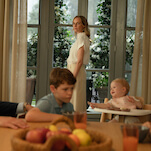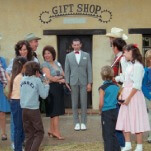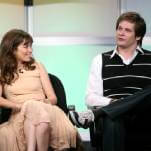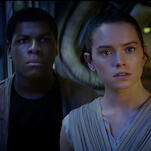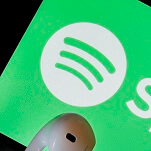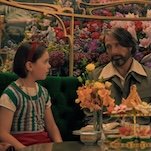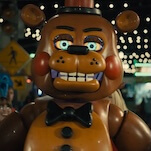When The Kids In The Hall first premièred on HBO in 1989, it carried with it the pedigree—and the onus—of Saturday Night Live’s Lorne Michaels. His executive-producer stamp on the Canadian comedy troupe’s introduction to America, combined with the sense of lawlessness granted by ad-free cable, set the expectation that Kids would be SNL’s more rambunctious cousin, the Toronto farm team that played a bit rougher than the broadcast big leagues. But audiences who tuned in expecting a slightly dirtier SNL—a skewering of the zeitgeist with more swears and nudity—were probably baffled to find a surrealist sketch series unlike anything U.S. viewers were then used to, particularly if they’d never caught Monty Python’s Flying Circus reruns on PBS.
Like Monty Python, Kids In The Hall inhabited a self-contained world built around original characters and absurdist setups, linked by wraparound sketches and short films that occasionally valued weirdness over funniness. Also like Python, the show’s comedic sweet spot was in the mundanity of the outrageous (the mass murderers and anal-probing aliens bored with their jobs), or the bizarre hidden within the normal (the hired whores and Satanic rituals lurking just behind every business meeting). And while it often tapped into the “slacker” zeitgeist with parodies of lazy, flannel-clad teens, and touched lightly on edgy topics such as homosexuality and AIDS, Kids all but eschewed contemporary references. Outside of, say, the occasional argument over Shelley Long, or the anomalous gag about Vanilla Ice, the show wisely stayed away from the pop culture of its era. As a result, just like Monty Python—and unlike other sketch shows such as SNL or SCTV—The Kids In The Hall’s comedy feels remarkably timeless.
Most obviously, the Kids also shared Python’s penchant for drag—though the Kids played female without a wink to the audience, unlike some of Python’s screechy caricatures. (Young male fans who found themselves sexually confused whenever Dave Foley donned a dress will surely agree.) This was true no matter how extreme their characters got: The Kids clung to the idea that comedy is funnier when it feels real. As a result, The Kids In The Hall boasts some of the most convincing acting, both in and out of drag, of any sketch series ever. Time and again it pulled off the unusual feat of making the audience feel genuine emotional connection to its men with cabbages for heads and its horny chicken ladies.
It’s somewhat ironic that another unique aspect of The Kids In The Hall was its zeal for exposing its own artificiality. From the very early episodes, the cast members reveled in acknowledging themselves as a sketch-comedy troupe putting on a TV show, and breaking the fourth wall to mock all the implied obligatory conventions. The second episode featured Foley listlessly explaining the basic formula for successful sketch comedy. That same season saw Kevin McDonald fretting that he might be booted from the troupe after coming up with just the nonsensical middle of a sketch. The very next episode saw both of them commenting on the obviously manufactured aspect of it all—as well as their newfound grind of making weekly TV—on “Premise Beach,” gleefully lobbing a bunch of wacky “what if?” setups to nowhere.
Whether it was a means of playing the upstart punks, or being preemptively defensive about their imagined audience reaction, this sort of self-effacement fell away as seasons wore on and Kids established its own conventions. Very quickly, the show grew a stable of recurring characters whose quirky idiosyncrasies became recognizable formulas. By the time the series wrapped in 1995, most of these characters had become surprisingly fleshed out; by then, even the Chicken Lady had an origin story. This had its own effect behind the scenes, as the troupe members became increasingly exhausted with their own show and longed for something else—the Brain Candy movie, most immediately, but also newer projects that would allow the Kids to more clearly define themselves as individual performers.
As anyone who’s watched even one episode of The Kids In The Hall knows, however, their individual identities were always well-established, to the point of the Kids practically being characters themselves. In addition to being the show’s de facto gay mouthpiece, Scott Thompson was the preening narcissist, both qualities coming together to form the flamboyantly dishy Buddy Cole, or his only slightly tongue-in-cheek proposals for a Scott Thompson Show spin-off. On the opposite end, McDonald was the neurotic, using his monologues to delve into his troubled family history, and presenting himself to the audience with intros like “or, as you might know me at home, the Kid In The Hall we don’t like.” McDonald was a performer so flop-sweat-desperate for the audience’s affection, one time he even filmed himself sleeping to seem more relatable.
His equally vaudevillian companion, Foley, was the affable everyman, using his natural, college-pal likability to complain about the tedium of being a mass murderer, or chuckle about his being such a dangerously bad doctor. Bruce McCulloch, the indignant rebel, had a chip on his shoulder about everything—jazz music, his small size, the sad way people eat their sandwiches—and, as the token flannel-clad rock ’n’ roller, he was the guy who did songs like “Daves I Know” and “Terriers.” And Mark McKinney—well, who knows who that guy is? He was the troupe’s go-to for weird accents and makeup, and even his monologues buried his true self under uglifying guises, like a cat on a prowl or a loser fascinated by his own festering leg wound.
With barely anyone else filling out the stage, the thrill of Kids was in the endless ways all these distinct personalities could be combined. McKinney and McCulloch excelled at putting satiric spins on manhood, taking on immature cops, fast-talking motivational seminar speakers, or businessmen whose important jobs amounted to little more than playacting. McCulloch and Thompson were just as excellent at being shifty dirtbags as they were gossipy secretaries. Thompson and Foley were as well matched playing glamorous Italian movie stars as they were playing sympathetic street hookers. And time and again, Foley was McDonald’s perfect foil and vice versa: Many of the show’s best sketches take place as simple conversations between the two, whether it’s McDonald chastising Foley for refusing to admit he’s right about Citizen Kane or for blowing up yet another planet during an undercover alien mission. Or it’s one of several party scenes where Foley meets McDonald and sarcastically chats him up, or deviously tells their boss that McDonald just confessed to being a bedwetter.
Naturally, it’s difficult for a list like this to delineate so many of these perfectly tuned moments (to reference just one fan-favorite sketch that unfortunately didn’t make the cut). Indeed, in a show where even the supposed filler—“Thirty Helens Agree” or “It’s A Fact,” for instance—has its own devoted following, little from The Kids In The Hall’s run seems dispensable. (Though there are certainly some diminishing returns in the sluggish fourth and fifth seasons.) This is also, regrettably, not a “Best Sketches” list: As they appear in the midst of less memorable material, several “all-time classics” have been sadly orphaned. Some are referenced in the “And if you like those…” section; many are not. There’s simply too much here to avoid leaving out someone’s favorites.
What follows is an effort to identify quality and quantity—the 10 episodes that boast the largest wealth of great sketches, and the ones that, together, paint as complete a picture of the Kids’ strange universe as possible.
Season One, Episode One: Thanks to years of honing their act on stage, and a one-hour pilot special that allowed them to learn the TV ropes a year earlier, the Kids’ first episode arrived in 1989 with a fully formed template for all episodes to follow. The series debut boasts characters that would become staples (McKinney’s bizarro pretend-vigilante, The Headcrusher, and his blackface bluesman, Mississippi Gary; also, the unlikely source of all Gary’s blues, McCulloch’s sassy receptionist, Kathi). It balances the surrealism of “The Pear Dream” (a spoof of pretentious art films) with the silliness of McCulloch’s community gym menace “The Eradicator” and “Ballet,” a sketch that mostly exists as an excuse for McDonald to look terrible in a leotard. And then, by way of saying hello to the Kids’ new TV audience, Foley announces that the troupe has discovered the cause of cancer: McCulloch, who grudgingly apologizes. And the line is drawn for the world to decide whether this is the sort of comedy it can get on board with.
Season One, Episode 17: The word “subversive” was often used to describe The Kids In The Hall, and this episode offers two examples of why. “The Middle” finds McDonald, “tired of writing the traditional comedy sketch,” presenting a bit of in medias res nonsense, then begging the audience to like it so he doesn’t get fired. Later, he and McCulloch mock an even older fashion of “traditional comedy,” as vaudevillians couching incredibly dark punchlines about abortion and existential despair in a corny soft-shoe routine. Amid all this razzing of comedy structure, the show also lands one of its cleverest Python-style callbacks, when Thompson’s lunkhead hockey fan—last seen getting molested by McKinney’s Dracula cosplayer in the opening sketch—links the show-closer, in which McDonald’s hopeless talk show host, Darcy Pennell, interviews Foley’s designer of fashion monstrosities intended for punishing ugly women.
Season One, Episode 20: Over a series run that offered some of the most brazenly sexual content in TV sketch-comedy history—in addition to exploring gay themes in an era when this was still considered risky—the Kids only had one major instance of pushing a network too far, with “Dr. Seuss Bible.” Decades of South Park and The Daily Show later, it’s rather quaint to look back on a singsong retelling of Jesus’ life and death at the hands of “the grumpity Jews” and think that something this goofy could cause such controversy. But the fact that “Dr. Seuss Bible” aired only once on HBO, and was totally banned in the Kids’ native Canada, lent the troupe a punk-rock edge that forever endeared it to its early-’90s, alterna-teen audience—even though, in terms of agitprop, it was no more radical than McCulloch’s piano-key-necktie-wearing bank rebel from the same episode. In fact, if anyone had call to protest, it’s really the estate of the late Buddy Holly, who finally gets exposed here as a drunk-with-power asshole who probably deserved to die.
Season Two, Episode Two: Demonstrating just how quickly the show reached the zenith of its powers, the second season kicks off with back-to-back classic episodes. Though the opener’s incredibly strong (boasting the Foley/McDonald all-time great “Delfar 7” and Bobby’s guitar duel with the Devil), the follow-up ekes out the nod due to the way it finds the troupe’s stable of recurring characters solidifying. The sole first-season holdover, McCulloch’s Cabbage Head, had already leaned so hard on his one note that his return here is really just a precursor to a late-season episode structured around killing him off. But after a half-dozen monologues, Thompson’s Buddy Cole has so earned the audience’s affection that he can don a sparkly minidress to coach a lesbian softball team and it still seems like a heroic celebration of homosexuality, rather than an offensive cartoon. And, in addition to the occasionally recurring “Suit Trappers,” this episode sees the introduction of two other beloved Kids team-ups that would come to define the series: McKinney and McCulloch’s totally incompetent “Cops,” and McDonald and Foley’s Sir Simon Milligan and Hecubus, whose equally inept definition of “evil” is spoiling the ending of Presumed Innocent.
Season Two, Episode Nine: One of the chief thematic undercurrents informing Kids’ comedy is man’s inevitable reckoning with his father, seen not only in the portrayal of asshole dads like McCulloch’s “Gordon,” but also in the series’ many ostensible “men” who behave like childish buffoons. The most memorable of these is “Daddy Drank,” in which McDonald reminisces about his abusive alcoholic father to both hilarious and heartbreaking effect, bookended with a closer in which the troupe chats about how they would first beat up, then admit they love their dads. Together with a sketch where McCulloch’s precociously weird Gavin clamors for his mom’s attention, a “Cops” interstitial where McKinney also admits he never loved his father, and a brief film where Foley holds a press conference to announce he’s disappointed with “pretty much the entire experience of parenting,” the episode has a loose, connective theme (a rarity for the show) that satirically explores the burdens of family. Add in a story in which The Headcrusher receives a savage comeuppance that lands him in the hospital, spiraling into a depression that causes him to question his whole sense of self, and you have an unusually psychologically rich half hour of sketch comedy.
Season Three, Episode Two: The Kids In The Hall was known to go heavy on the gay stereotypes, even as a means of combating them. Yet it was also groundbreaking in the way it made laughing at those stereotypes feel inclusive, particularly at a time when homosexuality was only just losing its taboo. Compared to the season-one sketch “Running Faggot” (or most of the stuff that got discussed in the later “Steps” segments, or really, any given Buddy Cole monologue) the opener of this episode—where Thompson is repeatedly accosted as a “fag” for his clothes—is fairly tame. But it’s also one of the show’s best comedic skewerings of homophobia, not least for the vicarious thrill of watching Thompson finally fight back. Of course, the real reason to recommend this episode is “Girl Drink Drunk,” a sublimely executed, Lost Weekend-style narrative tracing Foley’s descent into Tahitian Tee-Hee-fueled alcoholism. There’s also the series’ funniest appearance from McKinney’s pretentious Darryl character, seen here channeling his inner Bob Ross, and “Tiggy,” a simple joke about McDonald training his new dog that goes to the kind of bizarre length the Kids were so adept at pulling off.
Season Three, Episode Four: Amid a run of its series-best episodes, Kids offers up its most memorable wraparound with “Flying Pig,” a running gag in which McCulloch’s winged porker entertains people at “life’s many lineups” simply by showing up. It’s a silly premise that meets a surprisingly dramatic end, and later it even spawns a “Son Of Flying Pig” sequel, proving the show capable of making something emotionally affecting out of even its most ridiculous ideas. Elsewhere, Foley and McDonald’s fraternally hostile dynamic plays out at the golf course; Foley exercises his boyish charm as the world’s most polite axe murderer; Thompson’s Queen Elizabeth pleads with Canada in one of the show’s rare detours into “political” comedy; and the predictability of the Oscars ceremony is skewered with a succession of clips in which three Best Actor awards go to men playing self-righteous characters with disabilities (“I’ve got a spike in my head!”).
Season Three, Episode 14: The personalities of the individual Kids are clearly demarcated here in sketches that find them working mostly alone. McKinney is completely isolated in the wraparound, his wretched poetry-writing Japanese emperor showcasing McKinney’s loves of spoofing artistic pretension (see also: Darryl) and also of putting on weird disguises. McCulloch offers up his most intimate monologue yet, exploring the life of rock ’n’ roll loserdom that set him up for a show-business career. And Foley reprises another variation on his “bad doctor” persona, this time using his charisma to defend a surgery scar shaped like a swastika. There are also two of the show’s best examples of long-form storytelling: “King Of Empty Promises,” a masterful Foley/McDonald duet about lying, manipulative friends that’s as fully realized as any Oscar-nominated short film; and a funeral scene for Gavin’s mom—featuring the introduction of McDonald as his convict dad—which, in keeping with Kids’ commitment to investment in its characters, continued to have ramifications for Gavin going forward.
Season Four, Episode 11: The show’s addition to the late-night CBS lineup in 1992 had less of an impact than fans feared it would (save for inspiring a pointedly lame “Tarzan as a businessman” sketch, ostensibly written to please the new network overlords). But by the beginning of its fourth season, The Kids In The Hall had officially become one of the comedy institutions it had once so subtly mocked, with the now well-established troupe members becoming fragmented by their personal ambitions. That year saw a growing reliance on short films like “Love And Sausages,” “Cyril St. John,” “Sex Girl Patrol,” and “Detective Peter Prince”—all of them stylistic leaps that allowed their makers to show off their individual ranges, but many of them more strange than funny. (Though all these paled in comparison to “Chalet 2000,” an awkward, episode-length Buddy Cole “special” that even Thompson later regretted.)
A welcome anomaly was this episode, where the self-indulgence of the troupe performing The Sound Of Music’s “Do-Re-Mi” feels more like Kids simply having fun with the show’s raised production values. It also comes balanced out by old-fashioned stage pieces like McDonald’s anal-probing alien having a career crisis, McCulloch’s high-strung “I’m a good worker” weirdo trying to slip back into a job he’d just been fired from, another visit with struggling garage band Armada, and an increasingly rare, all-hands-on-deck sketch where most of the Kids play aging pals just hanging out, smoking their teens’ marijuana.
Season Five, Episode 21: In a testament to just how far the show came in such a short time, much of Kids’ series finale is spent providing a sense of sentimental closure to its characters—a rarity in sketch comedy, particularly when those characters are this bizarre. After a year that saw the Kids checking in one last time with the Chicken Lady, Gavin, the gay chorus of “Steps,” the street-singing “Hoe-De-Doe” guys, McCulloch and McKinney’s Por-eef-slinging motivational speakers, Francesca Fiore and Bruno Puntz-Jones, Darryl, Danny Husk, and its beloved cops and hookers, the final episode saw the Kids saying goodbye to their best characters: themselves.
The last gig from Rod Torfulson’s Armada (Featuring Herman Menderchuck) finds the garage band 30 years later, still cranking out the old tunes, growing ever more bitter about their attempts to “make it”—with obvious parallels to the Kids’ own fears of stagnation, and the difficulties of maintaining the group dynamic for so long. In one final monologue, Buddy Cole similarly muses on whether he could have done more to be a bigger success, then shrugs it off by burning everything down. And finally, the fourth wall is kicked one last time then totally obliterated, as Foley and McDonald present a series of censored “lost” sketches before the show’s faux-corporation AT&Love shuts its doors, sending the Kids out into the world without their wigs, but ready to find “a job almost exactly like this one.” Though their death as a troupe would prove to be short-lived, the closing shot of the Kids being buried alive provokes an audible twinge of grief from the studio audience—as it will from anyone else who’s come to enjoy inhabiting their weird little world.
And if you like those, here are 10 more: Season One, Episode Three (“Hey Man,” “Citizen Kane,” “Salty Ham”); Season One, Episode Seven (“Hotel La Rut,” “Plummet,” “Bobby’s First Poem”); Season Two, Episode Seven (“Lady Is A Tramp,” “Gavin: Painting A Chair”); Season Two, Episode 17 (“Ham Of Truth,” “Headcrusher: Rival,” “Demon Decorator”); Season Two, Episode 20 (“Gavin: Butcher Shop,” “Who’s To Blame?”, “Faux Pas,” “Hazy Movie”); Season Three, Episode One (“My Pen!”, “Chicken Lady Goes To The Strip Club”); Season Three, Episode Three (“Nervous Breakfast a.k.a. “Whole Lotta Milk-a,” “Gimmel 100,” “Raise a.k.a. Stuck In A Sketch”); Season Three, Episode Eight (“Wedding Virgin,” “Terriers”); Season Four, Episode Seven (“Chicken Lady Homecoming,” “He’s Hip, He’s Cool, He’s 45: Hiring,” “Things To Do”); Season Four, Episode 14 (“Plane Cannibal,” “Santa Says To Have Children,” “Borrowed Art”)
Availability: All five seasons have been released on DVD, and (as of right now) are available to stream on Netflix on Amazon Prime.































